Userpilot for Cohort Analysis: Features, Pricing, and Review
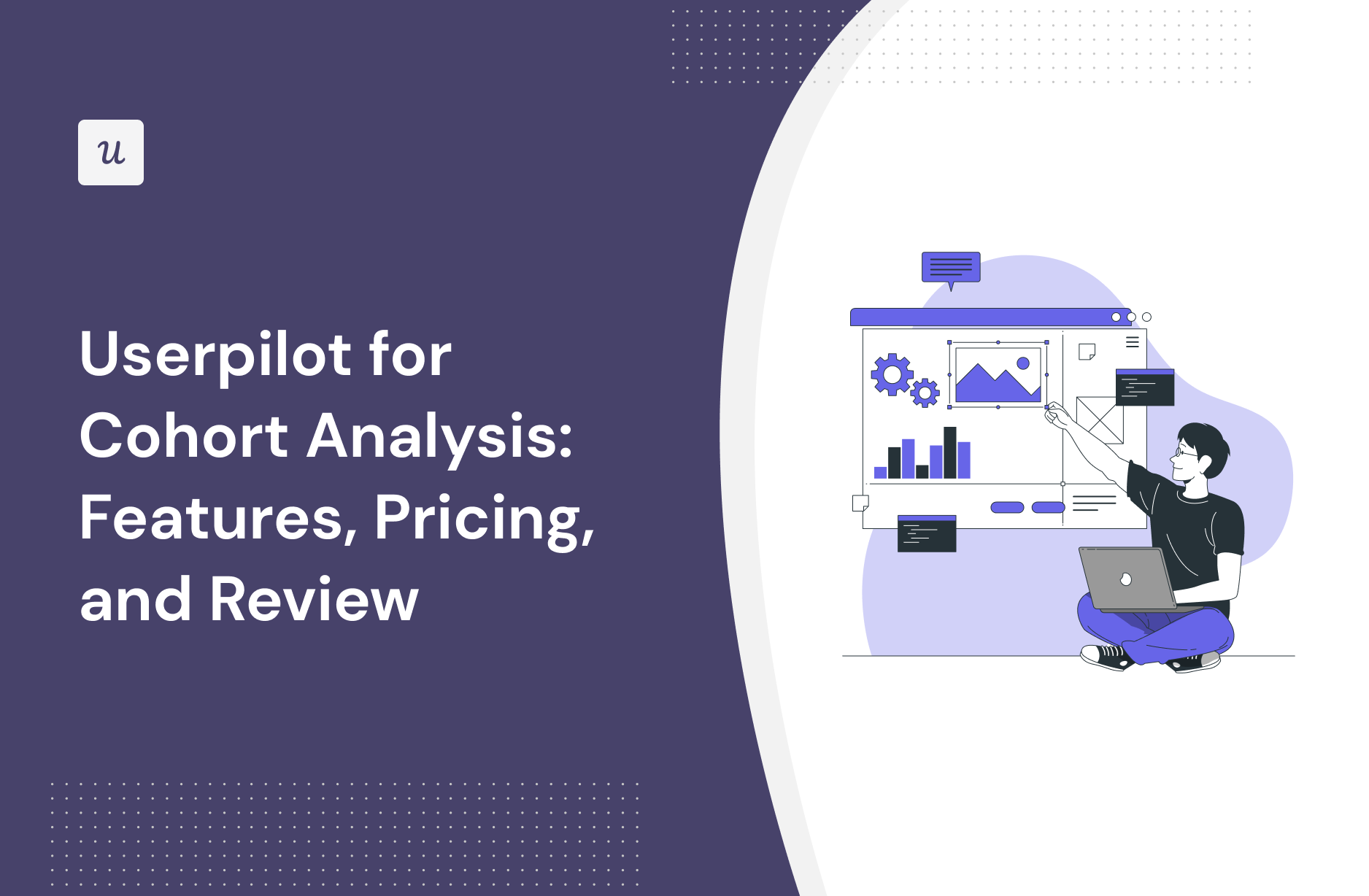
Looking for an effective cohort analysis tool and wondering if Userpilot is the best option for your SaaS company?
With numerous Userpilot alternatives, it can be challenging to make a final decision.
In this article, we’ll delve into precisely that – helping you determine whether Userpilot is the ideal choice for your cohort analysis needs. We’ll explore its features, pricing, and offer a comprehensive review to aid in your decision-making process.
Let’s get started!
TL;DR
- Cohort analysis is like having a microscope to examine your users’ journey. But what makes a cohort analysis tool truly instrumental? Here are some features to look for:
- Flexible customizations: Customize user group views based on the acquisition date, product usage, or demographics to understand individual behavior.
- Comprehensive metrics: A dashboard that gives access to key metrics like churn rate, retention, and average order value for a quick health checkup of user groups.
- Visualization tools: So that you can translate data into clear visuals to quickly identify trends and make informed decisions.
- Customer segmentation: Segmenting customers lets you customize marketing and product efforts. By addressing specific needs and interests, you ensure maximum impact every time.
- Retention analysis: To monitor user return rates to gauge product attractiveness and determine if users are engaged long-term.
- A/B testing: Test and refine strategies for various user cohorts. The goal? Enhanced conversion rates and user satisfaction.
- Other analytics tools: Cohort analysis tools should offer additional analytical features, like funnel analysis, heatmaps, and session recordings, so you can validate customer insights.
- For starters, Userpilot allows you to collect accurate data on user behavior inside web apps without any coding. Thanks to its Chrome extension, you can easily tag features and create custom events to track with a few clicks.
- Once you have the data, you can use it to build the cohort analysis table. Userpilot allows you to:
-
- Create cohorts on the user and company level.
- Choose the start and return events defining retention in your product, like ‘Signed in’ and ‘Invited teammate’.
- Filter the events by events, user, and company properties.
- Choose the interval by which you view the data (days, weeks, months) and date range (e.g. last 2 weeks, or last 180 days). Clicking on each cell reveals data on specific users that were retained. You can also visualize the average retention as a line graph, both linear and cumulative.
- You can enhance the insights from cohort analysis by pairing it up with other analytics features:
- Heatmaps – to analyze user clicks, hovers, and text infills on a page.
- Funnel analysis – to visualize user conversions and drop-offs at key stages in the journey.
- Trends analysis – to track key metrics over time.
- Paths – to visualize all the events leading up to or following a conversion.
- All in all, Userpilot is a good choice for cohort analysis when it comes to core features for cohort analysis such as paths, funnels, cohort analysis, and user segmentation analysis.
- Ready to see Userpilot in action? Schedule a demo today to explore its powerful cohort analysis capabilities firsthand.
What is Userpilot?
Userpilot is a product growth platform that drives user activation, feature adoption, and expansion revenue. It also helps product teams collect user feedback, streamline onboarding, and gather actionable insights from analytics.

With Userpilot, you’ll be able to track both product usage and user behavior to get a holistic view of how customers use your product — which will guide future development, improve the user experience, and inform your growth efforts.
Must have features of cohort analysis tools
Cohort analysis is like having a microscope to examine your users’ journey. But what makes a cohort analysis tool truly instrumental? Here are some features to look for:
- Flexible customizations: Customize user group views based on the acquisition date, product usage, or demographics to understand individual behavior.
- Comprehensive metrics: A dashboard that gives access to key metrics like churn rate, retention, and average order value for a quick health checkup of user groups.
- Visualization tools: So that you can translate data into clear visuals to quickly identify trends and make informed decisions.
- Customer segmentation: Segmenting customers lets you customize marketing and product efforts. By addressing specific needs and interests, you ensure maximum impact every time.
- Retention analysis: To monitor user return rates to gauge product attractiveness and determine if users are engaged long-term.
- A/B testing: Test and refine strategies for various user cohorts. The goal? Enhanced conversion rates and user satisfaction.
- Other analytics tools: Cohort analysis tools should offer additional analytical features, like funnel analysis, heatmaps, and session recordings, so you can validate customer insights.
Userpilot features for cohort analysis
User retention is critical for the success of digital products, it’s linked to the product’s ability to consistently deliver value to the users and is a key measure of business health. It is also essential in the process of achieving a product-market fit and retaining constant growth.
For starters, Userpilot allows you to collect accurate data on user behavior inside web apps without any coding.
Thanks to its Chrome extension, you can easily tag features and create custom events to track with a few clicks.
Once you have the data, you can use it to build the cohort analysis table.
Userpilot allows you to:
- Create cohorts on the user and company level.
- Choose the start and return events defining retention in your product, like ‘Signed in’ and ‘Invited teammate’.
- Filter the events by events, user, and company properties.
- Choose the interval by which you view the data (days, weeks, months) and date range (e.g. last 2 weeks, or last 180 days).

Clicking on each cell reveals data on specific users that were retained.
You can also visualize the average retention as a line graph, both linear and cumulative.
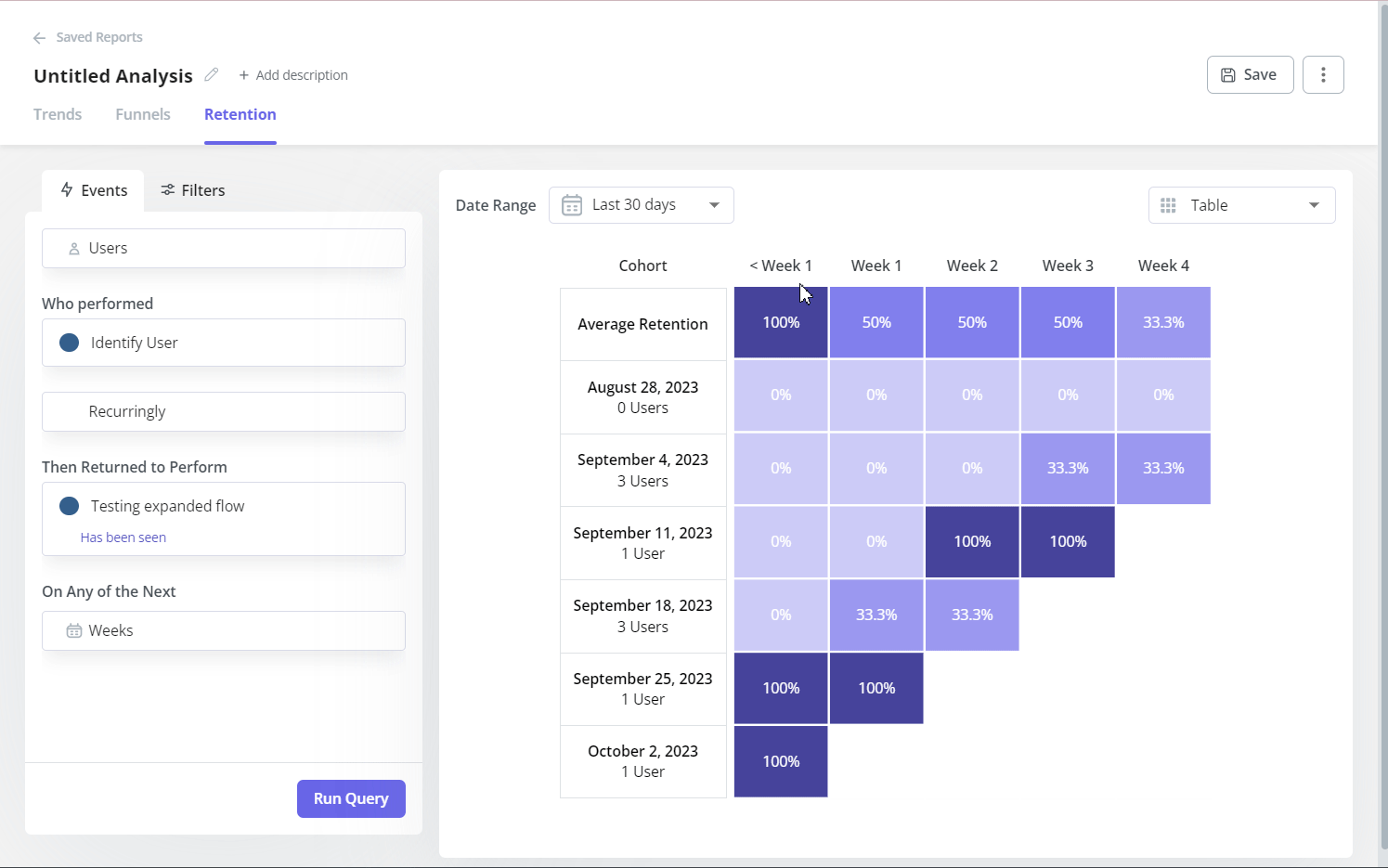
Cool isn’t it?
It gets even better!
You can enhance the insights from cohort analysis by pairing it up with other analytics features:
- Heatmaps – To analyze user clicks, hovers, and text infills on a page.
- Funnel analysis – To visualize user conversions and drop-offs at key stages in the journey.
- Trends analysis – To track key metrics over time.
- Paths – To visualize all the events leading up to or following a conversion.
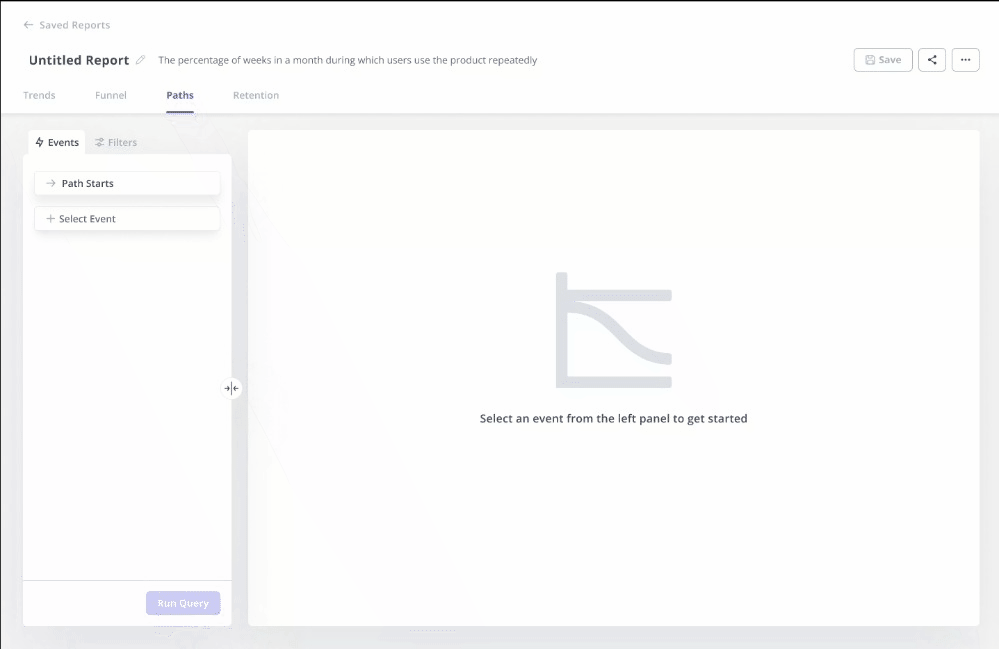
Userpilot’s paths
Path reports are essential for understanding user flows and journeys, offering invaluable insights into their interactions with our platform or application.
Within the Paths chart(s) visualization in Userpilot, you can:
- See the different flows/links users take from one step/event to another.
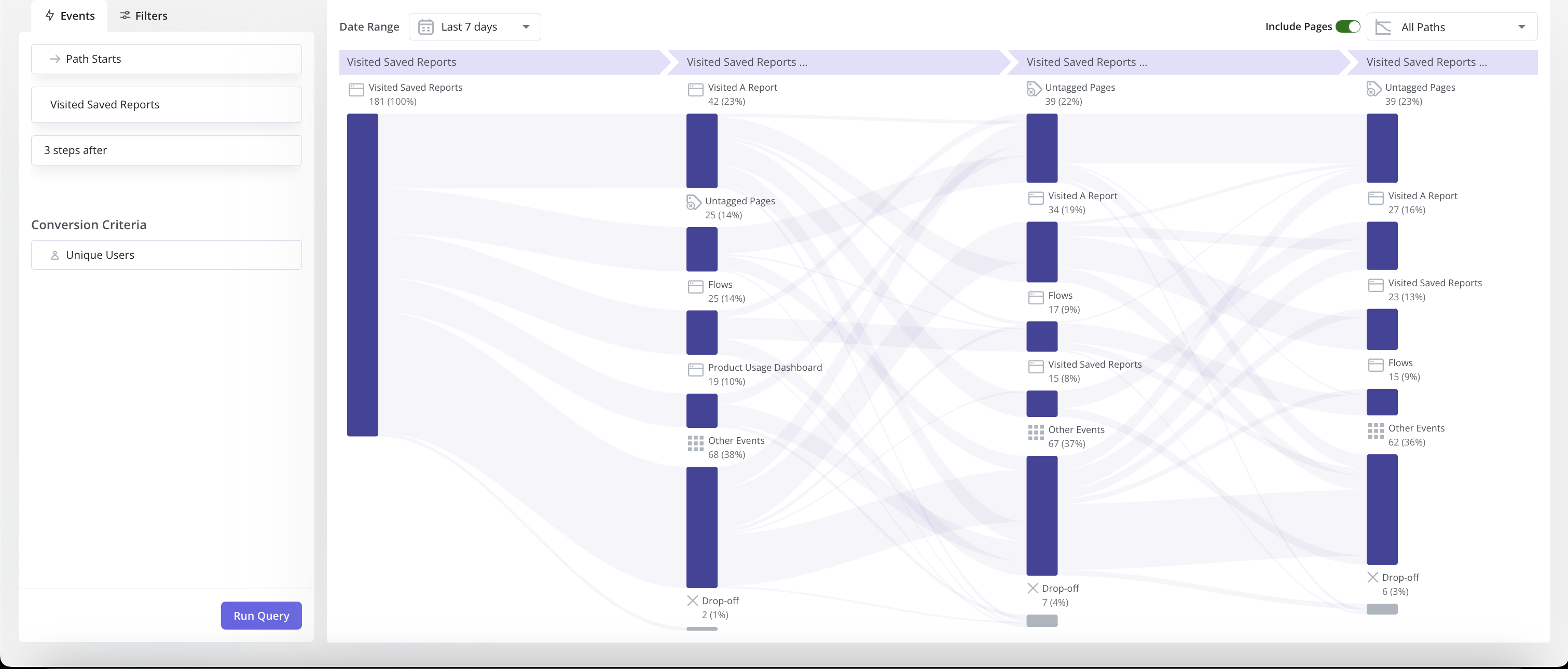
- Choose how many steps after or before the starting/ending event you want to report Users’ flows for.
- Choose whether you want to include Pages (i.e. Both User-Tagged and Untagged) in the visualization.
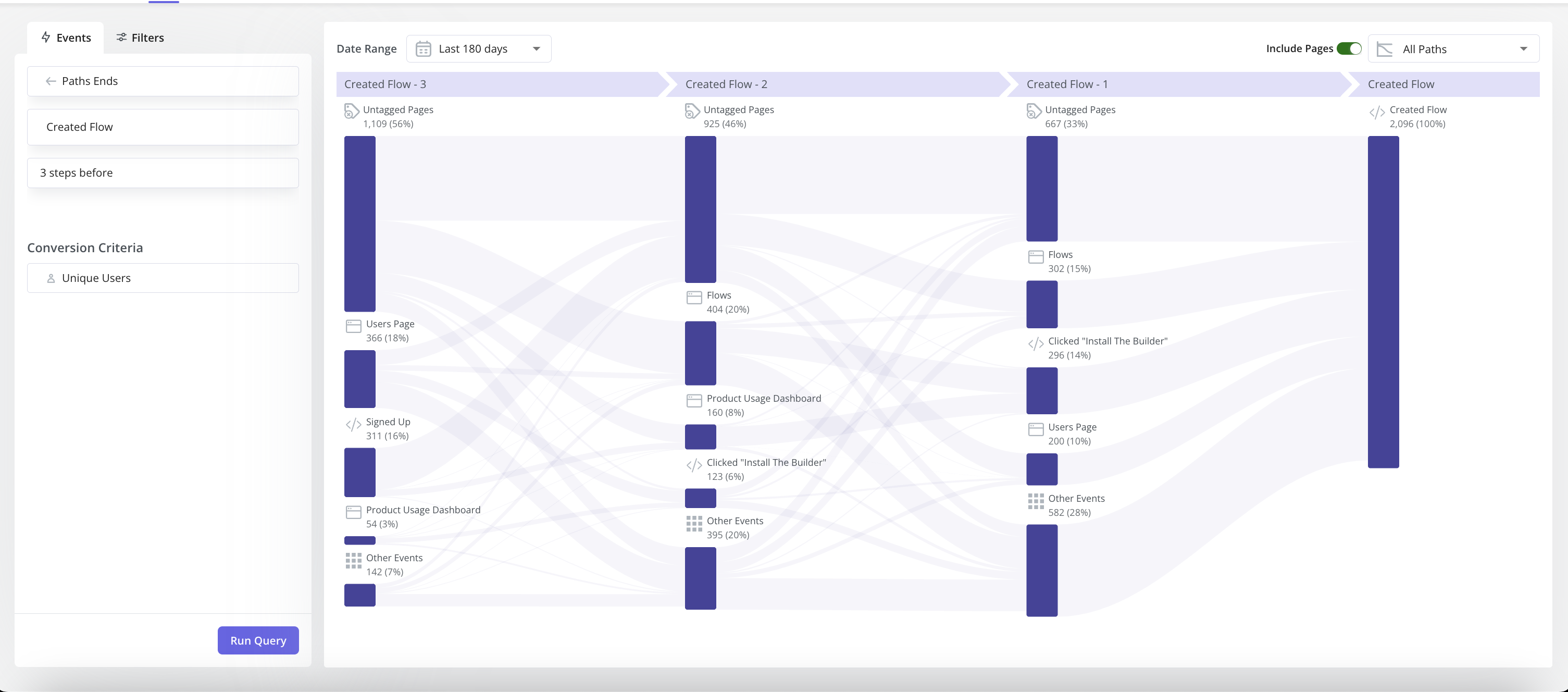
- Change the period of the analysis.
- Change the way you want to view the analysis: All Paths vs. Top Path (i.e. most common).

- Narrow down the targeted end-users by applying global or inline (event-specific) filters.
- View a breakdown of the end-users (or their associated companies) upon clicking on a specific node/step in the visualization chart.
You also have automatic path analysis in Userpilot’s core feature engagement analytics dashboards without having to set up anything. This will give you an overview of user navigation and engagement with your product so you have insights to work on improving their experience. 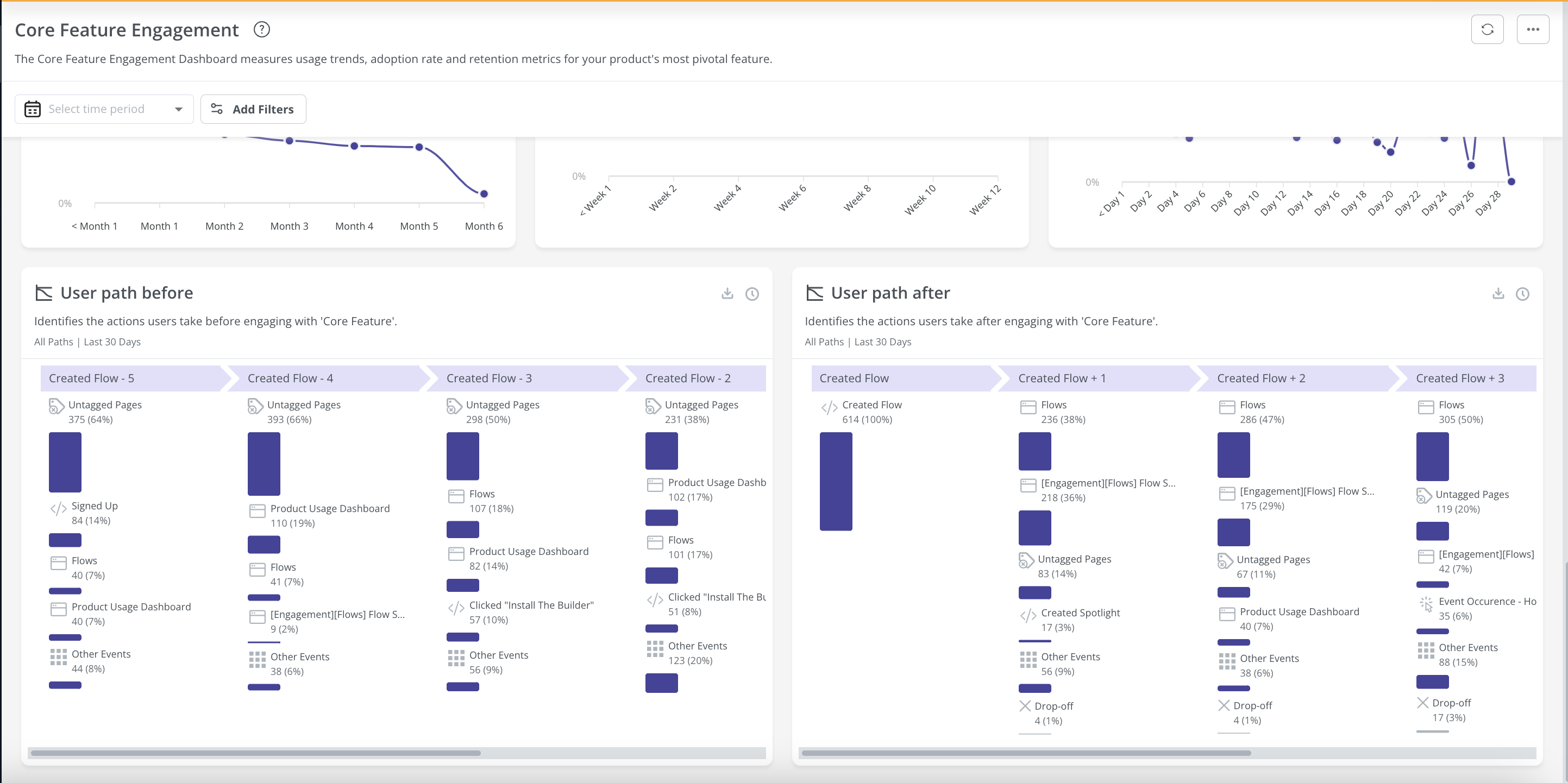
Userpilot’s funnels
Tracking user funnels is essential to getting a deeper understanding of the customer journey and reducing friction points. Userpilot helps you track user funnels by creating funnel reports, reviewing saved reports in bulk, and seeing key metrics like the average time it takes to complete a funnel.
Here’s how you can use Userpilot to generate funnel charts:
- Funnels: Userpilot’s funnel reports can show you the percentage of users that progress from one stage to another. Stages could consist of pages, actions, or other activation points. You can also set a specific order that these steps need to be completed or adjust the time period.

- Reports: The saved reports area of your Userpilot account lets you view, edit, duplicate, delete, or export (as a CSV file) all the analytics reports that you (or your teammates) have generated. You can also filter results by the teammate who created the report or the type of report.
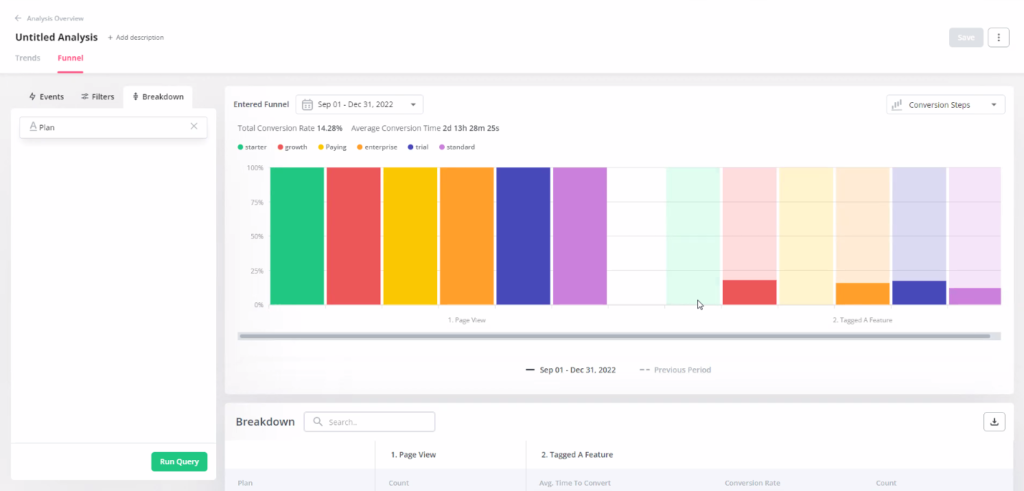
- Duration: The granular funnel analytics can offer more insights into each stage of a particular user funnel, such as how long it took the majority of your users to complete it from start to finish. You can filter by time period and set minimum/maximum parameters to remove outliers.

Userpilot’s cohort analysis
User retention is critical for the success of digital products, it’s linked to the product’s ability to consistently deliver value to the users and is a key measure of business health. It is also essential in the process of achieving a product-market fit and retaining constant growth.
For starters, Userpilot allows you to collect accurate data on user behavior inside web apps without any coding.
Thanks to its Chrome extension, you can easily tag features and create custom events to track with a few clicks.
Once you have the data, you can use it to build the cohort analysis table.
Userpilot allows you to:
- Create cohorts on the user and company level.
- Choose the start and return events defining retention in your product, like ‘Signed in’ and ‘Invited teammate’.
- Filter the events by events, user, and company properties.
- Choose the interval by which you view the data (days, weeks, months) and date range (e.g. last 2 weeks, or last 180 days).

Clicking on each cell reveals data on specific users that were retained.
You can also visualize the average retention as a line graph, both linear and cumulative.

Cool isn’t it?
It gets even better!
You can enhance the insights from cohort analysis by pairing it up with other analytics features:
- Heatmaps – To analyze user clicks, hovers, and text infills on a page.
- Funnel analysis – To visualize user conversions and drop-offs at key stages in the journey.
- Trends analysis – To track key metrics over time.
- Paths – To visualize all the events leading up to or following a conversion.

Userpilot’s user segmentation analysis
User segmentation is a key part of building a contextual onboarding experience for new customers. Userpilot lets you segment your customers when they meet specific conditions, filter through analytics using user attributes, and trigger flows for users in different segments.
Here are some of Userpilot’s customer segmentation capabilities:
- Conditional Segments: Userpilot lets you build segments for users who match conditions on what device/browser/OS they’re using, which country they live in, what their NPS score is, and any custom events they’ve performed. You can then use these segments as filters/triggers.
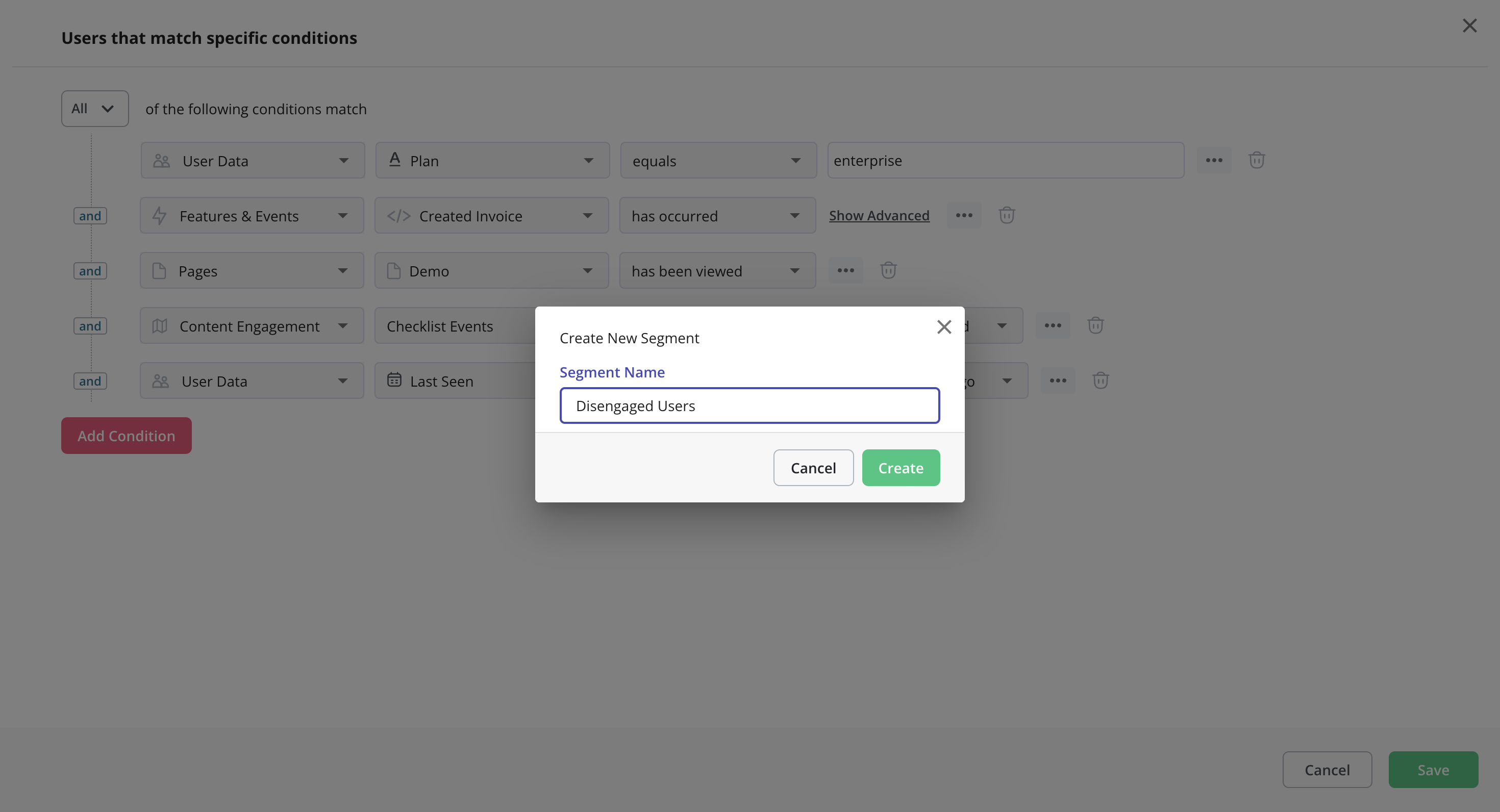
- Analytics Filters: The product analytics and user insights dashboards on Userpilot can be set to only show data from certain user segments or companies. This makes it possible to identify actionable insights from specific user cohorts and benchmark performance between segments.
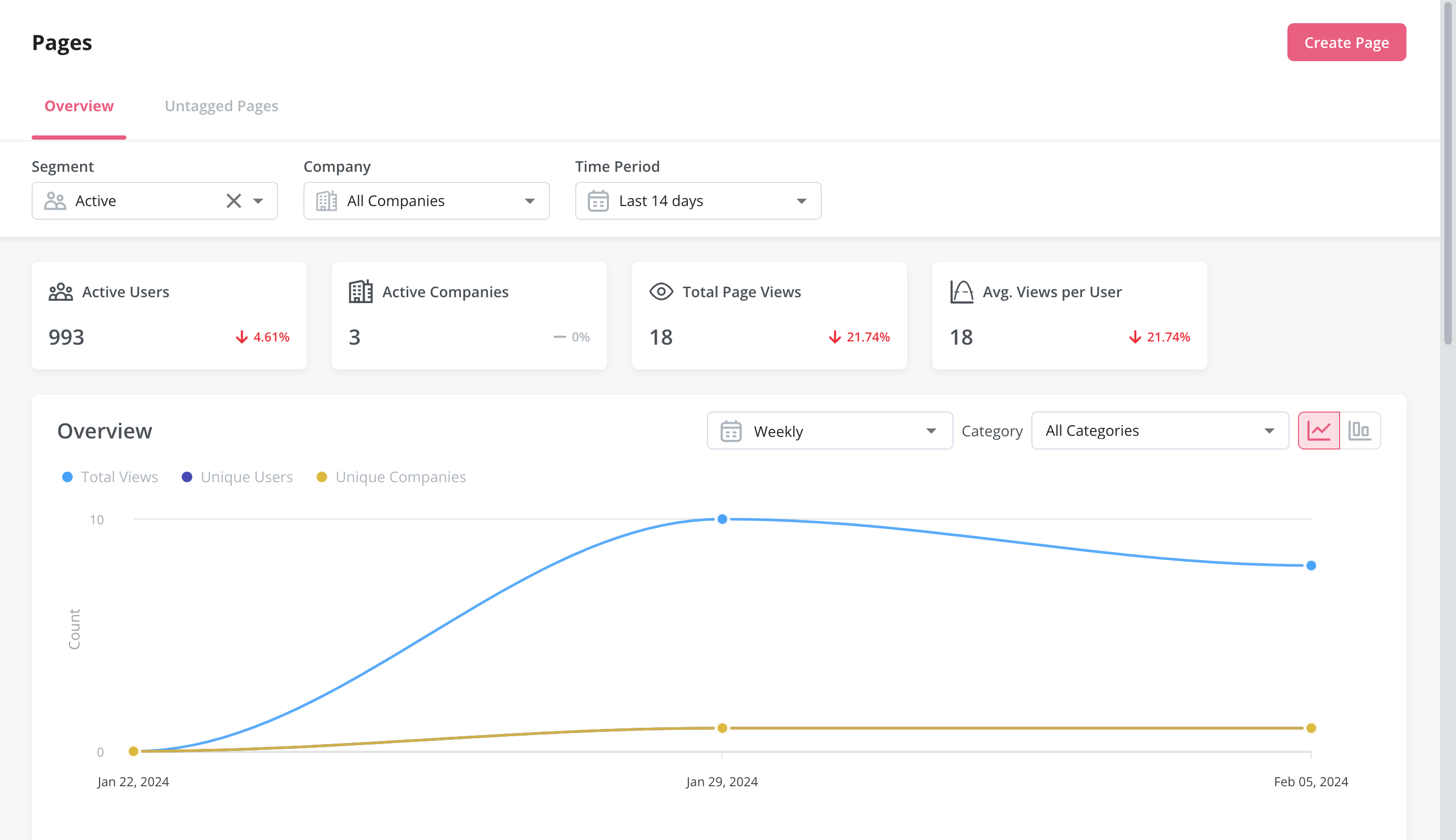
- Flow Triggers: Userpilot audience settings make it possible to target in-app flows to certain user segments or only show flows to users who meet specific conditions. You could also add event-based or page-specific triggers to show relevant flows with contextual timing.
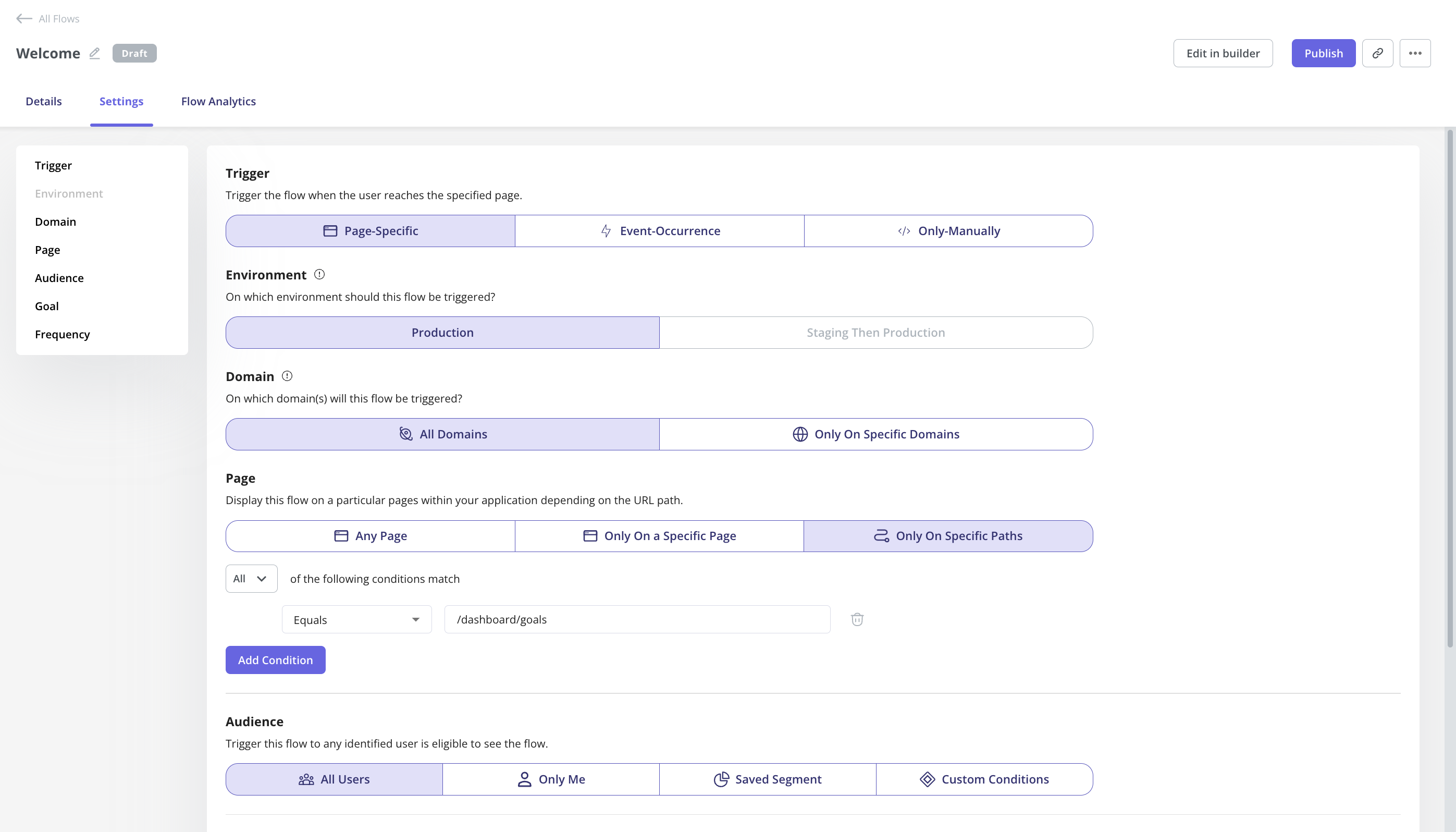
What are the pros and cons of Userpilot?
Userpilot’s pros
As a full-suite digital adoption platform, Userpilot has all the features you need to onboard users, track analytics, and gather feedback from customers without writing a single line of code. Here are a few pros of using Userpilot as your product growth solution:
- No-code builder: Userpilot’s Chrome extension lets you build flows, add UI elements, and tag features without writing a single line of code.
- UI patterns: There are plenty of UI patterns to choose from when using Userpilot, such as hotspots, tooltips, banners, slideouts, modals, and more!
- Startup-friendly: Userpilot’s entry-level plan gives you access to all available UI patterns so you can hit the ground running.
- Walkthroughs and flows: Build engaging interactive walkthroughs and personalized onboarding flows that target specific segments of your user base.
- Self-service support: Build an in-app resource center to help users solve problems, customize its appearance to align it with your brand, and insert various types of content (videos, flows, or chatbots) to keep your customers satisfied.
- A/B testing: Userpilot’s built-in A/B testing capabilities will help you split-test flows, iterate on the best-performing variants, and continually optimize based on user behavior.
- Feedback collection: Userpilot has built-in NPS surveys with its own unified analytics dashboard and response tagging to help you retarget users. There are other survey types to choose from and you can even create your own custom survey.
- Survey templates: There are 14 survey templates to choose from so you can gather feedback on specific features or run customer satisfaction benchmarking surveys like CSAT and CES.
- Advanced analytics: Userpilot lets you analyze product usage data, monitor engagement on all in-app flows, and use the data to create user segments that are based on behaviors instead of demographics.
- Event tracking: Userpilot’s no-code event tracking lets you tag UI interactions (hovers, clicks, or form fills) and group them into a custom event that reflects feature usage.
- Third-party integrations: Userpilot has built-in integrations with tools like Amplitude, Mixpanel, Kissmetrics, Segment, Heap, HubSpot, Intercom, Google Analytics, and Google Tag Manager so you can share data between all the solutions in your tech stack.
Userpilot’s cons
Of course, no tool is perfect and there are a few cons to consider before choosing Userpilot as your user onboarding or product growth solution:
- Employee onboarding: Currently, Userpilot only supports in-app customer onboarding.
- Mobile apps: Userpilot doesn’t have any mobile compatibility which could make it difficult for developers with cross-platform applications to create a consistent user experience for both versions of their product.
- Freemium plan: There’s no freemium Userpilot plan so those bootstrapping their startup and need sub-$100 solutions should consider more affordable onboarding platforms like UserGuiding or Product Fruits.
What do users say about Userpilot?
Most users laud Userpilot for its versatile feature set, ease of use, and responsive support team:
I recently had the pleasure of using Userpilot, and I must say it exceeded all my expectations. As a product manager, I’m always on the lookout for tools that can enhance user onboarding and improve overall user experience. Userpilot not only delivered on these fronts but also went above and beyond with its impressive new features, unparalleled ease of use, and truly exceptional customer support.
What truly sets Userpilot apart is its outstanding customer support. Throughout my journey with Userpilot, the support team has been responsive, knowledgeable, and genuinely dedicated to helping me succeed. Whenever I had a question or encountered an issue, their support team was always there to assist promptly, going above and beyond to ensure my concerns were addressed effectively.

Source: G2.
Of course, other users are also kind enough to share constructive criticism regarding specific features like event tracking filters:
“The filtration while analyzing specific events is a little confusing. Understanding of custom properties and data management configuration could have been more organised.”

Source: G2.
Userpilot’s pricing
Userpilot’s transparent pricing ranges from $249/month on the entry-level end to an Enterprise tier for larger companies.
Furthermore, Userpilot’s entry-level plan includes access to all UI patterns and should include everything that most mid-market SaaS businesses need to get started.

Userpilot has three paid plans to choose from:
- Starter: The entry-level Starter plan starts at $249/month and includes features like segmentation, product analytics, reporting, user engagement, user feedback, and customization.
- Growth: The Growth plan starts at $499/month and includes features like resource centers, advanced event-based triggers, unlimited feature tagging, AI-powered content localization, EU hosting options, and a dedicated customer success manager.
- Enterprise: The Enterprise plan uses custom pricing and includes all the features from Starter + Growth plus custom roles/permissions, access to premium integrations, priority support, custom contract, SLA, SAML SSO, activity logs, security audit and compliance (SOC 2/GDPR).
Conclusion
There you have it.
It should be easier now to make an informed decision whether Userpilot is your go-to option for cohort analysis. Ultimately, the best choice will depend on your product and current needs.
Book a Userpilot demo today to experience firsthand how it can enhance your user experience and drive product growth!


